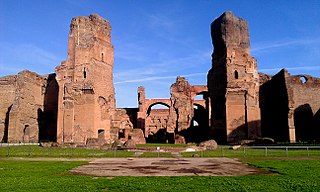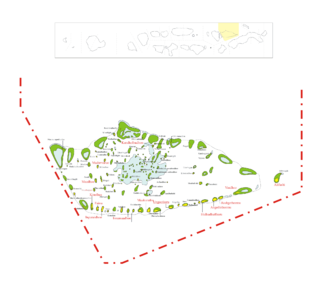Related Research Articles

The Baths of Caracalla in Rome, Italy, were the city's second largest Roman public baths, or thermae, after the Baths of Diocletian. The baths were likely built between AD 212 and 216/217, during the reigns of emperors Septimius Severus and Caracalla. They were in operation until the 530s and then fell into disuse and ruin.

Ngarchelong is a state in Palau. It is at the northernmost tip of the island of Babeldaob. Only the state of Kayangel is farther north.

Aimeliik is an administrative division of the island country of Palau. It is one of the Republic of Palau's 16 states. It has an area of 52 km2 and a population of 334. The state capital is the village of Mongami. The four other villages are Medorm, Imul, Elechui and Ngmechiangel.

Ngchesar, also known as Oldiais, is one of the sixteen states of the nation of Palau in Oceania.

Ngaraard is one of the 16 states of the Republic of Palau, and was originally named Kerradel.

Ngiwal is one of the sixteen states of Palau. It has a population of 282 and an area of 26 km2

Raa Atoll is an administrative division of the Maldives. The capital is Ungoofaaru. It includes Northern Maalhosmadulu Atoll proper and the island of Dhuvaafaru. Raa Atoll has the highest number of populated islands in the Maldives.

Velika Drenova is a village of about 5000 inhabitants in Trstenik municipality, Rasina District, Serbia. It is located on the Zapadna Morava River in the central Serbian area of Šumadija. Velika Drenova is the biggest producer of vine in Serbia and vinegrapes are a major export. Velika Drenova is also known by its grafters which is heard about all over the world. One of the biggest producer of vine is First Grafters Cooperative 1903.
Arsamosata was an ancient and medieval city situated on the bank of the Murat River, near the present-day city of Elazığ. It was founded in c. 240 BC by Arsames I, the Orontid king of Sophene, Commagene and possibly Armenia. The city served as a central center and royal residence of the Orontids of Sophene. The origin of its name is Persian, meaning "Joy of Arsames". Naming cities such as the "joy of" or "happiness of" was an Orontid practice that recalled the Achaemenid royal discourse.

Ngardmau is one of Palau's sixteen states and is located on the west side of Babeldaob between the states of Ngaraard and Ngeremlengui.

Lake Copais, also spelled Kopais or Kopaida, was a lake in the centre of Boeotia, Greece, west of Thebes. It was first drained in the Bronze Age, and drained again in the late 19th century. It is now flat dry land and is still known as Kopaida. A one-time island in the lake was modified in ancient times into a megalithic citadel, now called Gla. Lake Copais is also featured in Ubisoft's Assassin's Creed Odyssey (2018).
Elab (Chelab) is a village in the state of Ngaraard, north of the villages of Ngebuked and Ulimang. It is the home to Ngaraard's only private Christian (Protestant) high school, Bethania Girl's High School in Ngesang, a small portion of Elab village. In Ngesang, there is a Catholic church located here and a beautiful, white and shady beach, with rock outcroppings.
Chol (Choll) is a village at the northern end of Ngaraard State in Palau. This village consists of a large, long, beach that runs along its entire east coast. The village has a series of ancient paths and platforms, similar to the rest of the villages in Ngaraard. There is also a large man-made channel that connects the village to the sea on the western coast. At the center of the village, along the compact road, there is a small marketplace with benches where one can purchase some village refreshments.
The village of Ulimang is where the Ngaraard State Office is located. Another state office branch is located in Meketii, Koror. Ngaraard Elementary school is located here. Ulimang's coast is an orange, sandy beach, and a small, high dock reaching out into the ocean. There is a large, red, public resting house near the dock. The villages of Ngesang in Elab are located north of this village. To the west is Ngebuked and to the south is Ngkeklau.
Ngkeklau is a populated area in the southern region of the state of Ngaraard in the Republic of Palau. The town has a small population, on the east coastal plains of Ngaraard. The town includes several ancient relics of stone, such as stone paths, platforms, and burial sites.
Ngesang is a small portion of the village of Elab, Palau, and the area where most of Elab's inhabitants live. It is also the location of Ngaraard's Bethania High School for girls. Ngesang is located on the eastern shore of Ngaraard State. It has shady beaches canopied with large trees. On the northern end of Ngesang is the beginning of the ancient stone pathways that connects the east and the west coasts. Ngesang Chief is Uong and the meeting bai for men and women club is BairaTuich.

Melekeok is a state of the Republic of Palau located on the central east coast of Babeldaob Island. The seat of government of the country, Ngerulmud, is located in the state. The state consists of long beaches, hills, steep ridges, rivers, and the largest and only natural freshwater lake in Palau and Micronesia, Lake Ngardok.

Mount Mogan or Moganshan is a mountain located in Deqing County, Huzhou, Zhejiang Province, China, 60 kilometers from the provincial capital Hangzhou and 200 km from Shanghai. It is part of the Moganshan National Park and at its base is the small town of Moganshan.

The Malian or Maliac Gulf is a gulf in the western Aegean Sea. It forms part of the coastline of Greece's region of Phthiotis. The gulf stretches east to west to a distance of 15 to 22 kilometers, depending on the definition, and is very shallow, with a maximum depth of 27 meters (89 ft). The only harbour is that of Stylida, which serves the city of Lamia. To its east is Cape Lichada, the northwesternmost point of the island of Euboea.

The Tangut dharani pillars are two stone dharani pillars, with the text of a dhāraṇī-sutra inscribed on them in the Tangut script, which were found in Baoding, Hebei, China in 1962. The dharani pillars were erected during the middle of the Ming dynasty, in 1502, and they are the latest known examples of the use of the Tangut script. They are also very rare examples of Tangut monumental inscriptions outside of the territories ruled by the Western Xia dynasty. The only other known example of an inscription in the Tangut script that has been found in north China is on the 14th-century Cloud Platform at Juyongguan in Beijing. These pillars indicate that there was a vibrant Tangut community living in Baoding, far from the Tangut homeland in modern Ningxia and Gansu, during the early 16th century, nearly 300 years after the Western Xia was annihilated by the Mongol Empire.
References
- ↑ "Google Earth". earth.google.com. Retrieved 2020-09-21.